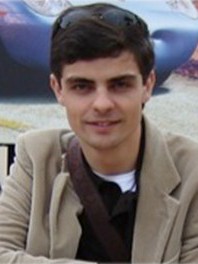abstract
Corrole macrocycles are very appealing dyes for incorporation into light harvesting devices. This work shows the sensorial ability of 5,10,15-tris(pentafluorophenyl)corrole 1 and its monoanionic species toward Na2+, Ca2+, Cu2+, Cd2+, Pb2+, Hg2+, Ag+, and Al3+ metal ions in toluene and acetonitrile. The photophysical studies toward metal ions were carried out by absorption and emission spectroscopy. From all metal ions studied, corrole 1 shows to be colorimetric for Hg2+ allowing a naked eye detection of Hg2+ through a change of color from purple to blue in acetonitrile and from green to yellow in toluene. In addition a new beta-imine corrole 4 was successful synthesized and further functionalized with 3-isocyanatopropyl-trimethoxysilane resulting in an alkoxysilane derivative 5. The grafting of alkoxysilane derivative 5 with optically transparent silica nanoparticles (SiNPs) was achieved succesfully. The new-coated silica nanoparticles with corrole 5 were studied in the presence of Cu2+, Hg2+ and Ag2+ as metal ion probes. Interestingly, upon addition of Ag+, groups of satellite AgNPs were formed around the SiNPs and were checked by transmission electron microscopy (TEM). At same time, a change of color from green to yellow was observed.
keywords
FREE-BASE CORROLES; SINGLET OXYGEN GENERATION; PHOTOPHYSICAL PROPERTIES; SELECTIVE FLUORESCENT; PERIODIC-TABLE; DERIVATIVES; CONSTANTS; BEHAVIOR; MERCURY; SYSTEMS
subject category
Chemistry
authors
Santos, CIM; Oliveira, E; Fernandez-Lodeiro, J; Barata, JFB; Santos, SM; Faustino, MAF; Cavaleiro, JAS; Neves, MGPMS; Lodeiro, C
our authors
acknowledgements
Authors are grateful to the Scientific PROTEOMASS Association (Portugal) for financial support. Thanks are due to the Fundacao para a Ciencia e Tecnologia (FCT, Portugal), European Union, QREN, FEDER, and COMPETE for funding the QOPNA research unit (project Pest-C/QUI/UI0062/2011) and the Portuguese National NMR Network, also supported by funds from FCT. C.S., E.O, J.F.B.B, and S.M.S. also thank FCT-MEC (Portugal) for their doctoral and PostDoctoral grants, SFRH/BD/64155/2009 and SFRH/BPD/72557/2010, SFRH/BPD/63237/2009, and SFRH/BPD/64752/2009, respectively. J.F.L. thanks Scientific PROTEOMASS Association (Portugal) for financial Postdoctoral support.



